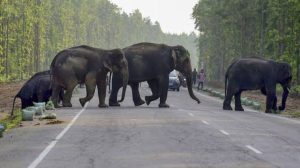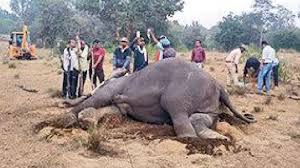Digital News Guru:
In a tragic turn of events, 10 elephants were found dead in Madhya Pradesh’s Bandhavgarh Tiger Reserve, sparking concern and scrutiny over the circumstances of their deaths. Preliminary investigations suggest that the elephants, part of a herd of 13, may have died from suspected poisoning after consuming food potentially contaminated with toxic substances. This marks a troubling incident of mass elephant deaths in the region and has triggered an in-depth probe to identify the exact cause and prevent future occurrences.
Discovery of the Elephants’ Deaths
The discovery of the carcasses shocked both local residents and wildlife officials, given the rarity of such mass fatalities within a single herd. The incident unfolded over a few days, during which villagers near the Bandhavgarh reserve noticed the absence of a familiar group of elephants that had been migrating through the forest. Upon investigation, wildlife officials discovered the lifeless bodies of the animals in close proximity to each other, an indication that they likely consumed contaminated food from the same source.
Early reports have indicated that the elephants may have consumed kodo millet, a staple crop in parts of Madhya Pradesh. Officials suspect that the millet may have been laced with toxic chemicals, either unintentionally through pesticides or deliberately as an attempt to prevent crop raiding. Wildlife officials and toxicologists are now conducting tests to determine the specific toxins that might have led to the elephants’ deaths.
Potential Causes of Contamination
Several possible causes are being explored. One of the primary suspects is the use of pesticides, often applied in millet fields to deter pests and occasionally used in areas prone to crop-raiding by wild animals. In many parts of India, elephants wandering into agricultural areas in search of food can lead to conflict with farmers. Pesticides, when misused or applied in excess, can become deadly if ingested by animals, especially large herbivores like elephants.

Another possibility is that the millet was deliberately poisoned to deter elephants from entering the farmland. Human-elephant conflicts have become increasingly common in recent years as human settlements and farmlands expand into traditional elephant territories. As a result, some farmers use poisons to keep animals out of their crops. Although officials are wary of drawing early conclusions, they have noted a history of similar conflicts in the region that sometimes result in extreme measures to protect crops.
Environmental Impact and Conservation Challenges
The loss of ten elephants, a keystone species in forest ecosystems, raises significant environmental and ethical questions. Elephants are essential for maintaining biodiversity and supporting the ecological balance in their habitats, as their activities such as seed dispersal and creating pathways benefit various other species. The death of such a large number of elephants in a single event can disrupt the social structure of elephant groups, which are typically led by experienced matriarchs and rely on strong familial bonds.
In addition to the environmental impact, this incident highlights broader conservation challenges. India is home to nearly 60% of Asia’s elephant population, and while the country has implemented laws to protect them, elephants face persistent threats from habitat loss, poaching, and increasing human encroachment. The Bandhavgarh case underscores the need for effective policies and protective measures to prevent future incidents of poisoning or conflict.

Investigation and Response from Authorities
In response to the incident, Madhya Pradesh’s state government has launched an official investigation. Wildlife authorities and forensic experts are examining samples from the elephants’ carcasses, surrounding soil, and vegetation to identify any toxic substances. Additionally, agricultural and forest officials are conducting interviews with local farmers and inspecting nearby fields to ascertain if any agricultural chemicals were improperly used. The state’s forest department is also reviewing existing regulations on pesticide use and considering measures to raise awareness among farmers regarding the implications of these chemicals on local wildlife.
Local conservationists and environmental groups have been quick to react, calling for swift action to prevent such incidents from reoccurring. Some experts have suggested establishing buffer zones around forest reserves to reduce the likelihood of wildlife straying into farmland. Another proposed solution is to educate and assist farmers in using alternative, non-lethal deterrents that could protect crops without posing a danger to wildlife.
Long-Term Solutions for Human-Wildlife Conflict
The unfortunate deaths of the Bandhavgarh elephants underline a growing problem in India—human-wildlife conflict. As human populations and agricultural activities expand, interactions between wildlife and human settlements are becoming increasingly common and often result in conflict. This situation is particularly acute for elephants, who roam over large distances and often find themselves in close proximity to agricultural lands.

Experts argue that lasting solutions to this problem will require a multi-pronged approach, including policy adjustments, community engagement, and technological innovation. For instance, community-based conservation programs that involve local populations in wildlife protection efforts have shown promise in other parts of India. These programs emphasize coexistence and offer support to farmers affected by wildlife raids, often compensating them for crop losses or damaged property.
Technology can also play an instrumental role in conflict mitigation. In recent years, several areas have implemented elephant tracking systems and early warning networks that notify communities when elephants are nearby, allowing them to take preventive measures. Drone technology, surveillance cameras, and SMS-based alert systems have been utilized in some regions to track elephant movements and reduce the risk of unexpected encounters.
Conclusion
The Bandhavgarh elephant deaths represent a sobering reminder of the challenges of managing human-wildlife interactions in a densely populated and rapidly developing country. While the exact cause of the poisoning is still under investigation, the incident has prompted a reevaluation of current wildlife conservation practices and the need for sustainable conflict management strategies.
Protecting wildlife, especially endangered and keystone species like elephants, requires collaborative efforts from conservationists, government agencies, and local communities. Incidents such as this underscore the urgency of creating and enforcing policies that prioritize both biodiversity conservation and the livelihoods of rural populations who coexist with wildlife. Through greater awareness, sustainable agricultural practices, and innovative conservation methods, India can work toward a future in which tragic incidents like those at Bandhavgarh are prevented, preserving both its natural heritage and the welfare of its people.
You May Also Read: Unity vs. Division: Mayawati Slams BJP-SP Tactics Before Uttar Pradesh Bypolls








